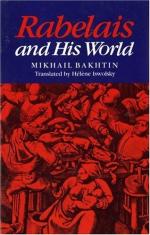
|
| Name: _________________________ | Period: ___________________ |
This quiz consists of 5 multiple choice and 5 short answer questions through Chapter 7, Chapter 2, Language of the Marketplace Cont..
Multiple Choice Questions
1. Bakhtin asserts that the advertisement for "pantagruelion" in the Third Book expresses:
(a) The natural mistrust the common folk have for druggists.
(b) The existentialist confusion of Renaissance marketplace culture.
(c) The cynicism rampant in Rabelais' writing.
(d) The deep optimism inherent in Rabelais' view of marketplace culture.
2. The combination of solemnity and joking in the tone of the Prologue to the Third Book indicates:
(a) The complex explanation of the Prologue to the readers.
(b) The opinion that humor must be subordinate to seriousness.
(c) The importance and necessity of laughter.
(d) The confusion the author experiences with this combination.
3. What are the targets of the abusive language in Rabelais' prologue to the Third Book?
(a) Members of the aristocracy whose political ideals are not in keeping with Rabelais' ideals.
(b) Average townsfolk who have imbibed too much wine.
(c) Foreign travelers who have offended the traditions of Carnival.
(d) Representatives of old, hypocritical, serious Medieval philosophy.
4. When did the Russian Revolution occur?
(a) 1917.
(b) 1936.
(c) 1945.
(d) 1850.
5. With what portion of the body is grotesque debasement most concerned?
(a) The arms and legs.
(b) The spiritual interior essence.
(c) The head and eyes.
(d) The material lower stratum.
Short Answer Questions
1. According to Bakhtin's semiotic understanding, what irony is inherent within the creative power of language?
2. Why was Rabelais linked so closely to the Lyon fairs?
3. How does Bakhtin interpret the relevance of the cries of Paris to Renaissance France?
4. In the Renaissance, bodily excretions were closely associated with:
5. How did the French Romanticists respond to Rabelais' works?
|
This section contains 396 words (approx. 2 pages at 300 words per page) |

|




